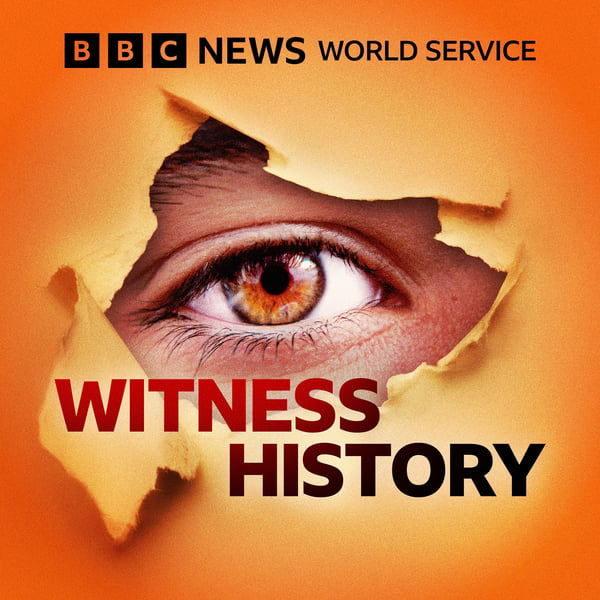The world's first general purpose electronic computer
Witness History
BBC
4.4 • 1.6K Ratings
🗓️ 9 October 2024
⏱️ 10 minutes
🧾️ Download transcript
Summary
In 1946, one of the world’s first electronic computers was unveiled in Philadelphia, in the USA.
It was called the Electronic Numerical Integrator and Computer, or ENIAC, and was initially designed to do calculations for ballistics trajectories.
It was programmed by six female mathematicians.
Rachel Naylor speaks to Gini Mauchly Calcerano, whose dad John Mauchly co-designed it, and whose mum, Kay McNulty, was one of the programmers.
Eye-witness accounts brought to life by archive. Witness History is for those fascinated by the past. We take you to the events that have shaped our world through the eyes of the people who were there. For nine minutes every day, we take you back in time and all over the world, to examine wars, coups, scientific discoveries, cultural moments and much more.
Recent episodes explore everything from football in Brazil, the history of the ‘Indian Titanic’ and the invention of air fryers, to Public Enemy’s Fight The Power, subway art and the political crisis in Georgia. We look at the lives of some of the most famous leaders, artists, scientists and personalities in history, including: visionary architect Antoni Gaudi and the design of the Sagrada Familia; Michael Jordan and his bespoke Nike trainers; Princess Diana at the Taj Mahal; and Görel Hanser, manager of legendary Swedish pop band Abba on the influence they’ve had on the music industry. You can learn all about fascinating and surprising stories, such as the time an Iraqi journalist hurled his shoes at the President of the United States in protest of America’s occupation of Iraq; the creation of the Hollywood commercial that changed advertising forever; and the ascent of the first Aboriginal MP.
(Photo: Computer operators programming the ENIAC. Credit: Corbis via Getty Images)
Transcript
Click on a timestamp to play from that location
| 0:00.0 | Before you listen to this BBC podcast I'd like to tell you why I love |
| 0:03.7 | podcasting I'm Natasha Aronson I'm an assistant commissioner for the BBC and I work on |
| 0:09.4 | making podcasts my real passion is discovering unbelievable unheard stories and working with the biggest |
| 0:16.9 | stars who can really bring those stories to life. |
| 0:20.0 | I love the whole process of making podcasts from the spark of an idea to hearing the final edit. |
| 0:26.0 | There's nothing like it. |
| 0:28.0 | What makes BBC podcast special is that we're working for you. |
| 0:31.0 | So whatever we commission has to reflect the things that you care about |
| 0:34.4 | and love wherever you are in the UK. So if you like this BBC podcast, there's so much more to |
| 0:39.5 | discover. Have a listen on BBC sounds. You're listening to the BBC World Service and now the Witness History Podcast with me, Rachel Naylor. |
| 1:02.0 | I'm taking you back to when the world's first electronic computer was invented in the 1940s, the ENYAC. It was programmed by six female mathematicians during the Second |
| 1:06.1 | World War to do calculations for the US Army. I've been speaking to the daughter of one of them. It's June 1942 and we're in Philadelphia. |
| 1:18.0 | Irish Maths graduate Kathleen K McNulty |
| 1:21.0 | has just got her first job as a computer at the University of Pennsylvania. |
| 1:25.1 | That's right, back in the 1940s computers were people and more specifically women as the men |
| 1:31.8 | were busy fighting in the war. |
| 1:33.6 | And Kaye was hired to calculate ballistic trajectories. |
| 1:37.0 | Calculating one path of a shell would take 750 multiplications, as they had to take into account |
| 1:42.2 | factors like wind, temperature and terrain, as Kay told the BBC in 1991. |
| 1:47.0 | To do just one trajectory at one particular angle usually took somewhere between 30 and 40 hours of calculation on this |
| 1:56.8 | desk calculator. |
| 1:58.6 | And these trajectories, after they were done, were going to be incorporated in a firing table and one needed about |
... |
Please login to see the full transcript.
Disclaimer: The podcast and artwork embedded on this page are from BBC, and are the property of its owner and not affiliated with or endorsed by Tapesearch.
Generated transcripts are the property of BBC and are distributed freely under the Fair Use doctrine. Transcripts generated by Tapesearch are not guaranteed to be accurate.
Copyright © Tapesearch 2025.

